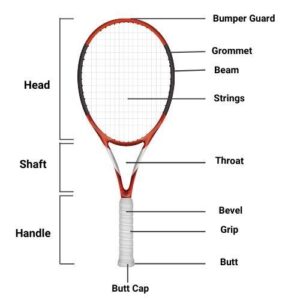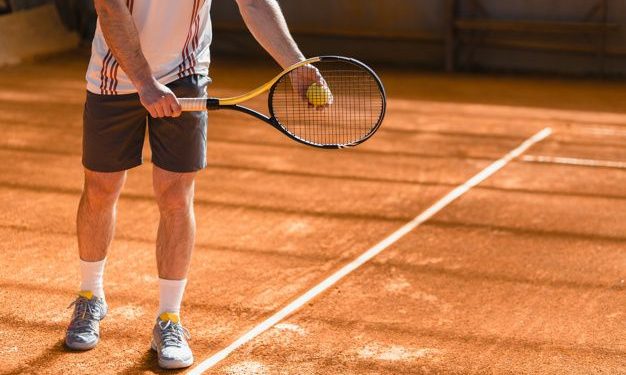Parts of a Tennis Racket?
A tennis racket consists of several parts that work together to create a functional and effective tool for playing tennis. The main parts include the Head, String Bed, String, Grommets, Frame, Shaft, Handle, Butt Cap, Dampener, Grip, Beam, and Thoart:

- Head: The head of the racket is the oval-shaped frame that holds the strings. It is divided into two parts: the string bed and the hoop. The size of the head can vary, with larger heads providing a larger hitting surface and a more forgiving sweet spot.
- String Bed: The string bed is the area within the head where the strings are woven or strung. It is responsible for striking the ball and imparting spin, power, and control.
- Strings: The strings are the thin, interconnected fibers that span the width of the head. They are typically made of materials such as nylon, polyester, or natural gut. The tension of the strings can be adjusted to suit a player’s preferences for power or control.
- Grommets: Grommets are small plastic or metal tubes that surround the holes through which the strings pass. They help protect the strings from friction and damage caused by contact with the frame.
- Frame: The frame is the main structure of the racket, forming the perimeter of the head. It provides stability and support to the strings and helps distribute the impact of the ball evenly across the string bed.
- Shaft: The shaft is the long, narrow section of the racket that connects the head to the handle. It provides additional stability and contributes to the overall flex and feel of the racket.
- Handle: The handle, also known as the grip, is the part of the racket that a player holds during gameplay. It is typically covered with grip material, such as synthetic or natural materials, to provide comfort and traction.
- Butt Cap: The butt cap is located at the bottom end of the handle. It serves as a finishing piece and can be removed to access the inside of the handle for customization or replacement of the grip.
These are the key parts of a tennis racket that work together to enable players to hit the ball with control, power, and spin.
The Frame
The frame of a tennis racket forms its main structure and determines its overall characteristics. Several factors contribute to the frame’s performance, including head size, length, weight, and balance.
Head Size
The head size of a racket refers to the surface area available for striking the ball. Rackets with larger head sizes offer more forgiveness and power but may sacrifice some control. Smaller head sizes provide greater control but require more precision in your shots.
Length
The length of a tennis racket affects its maneuverability and reach. Standard rackets are typically 27 inches long, but longer rackets offer increased leverage and power, while shorter rackets provide better control and maneuverability.
Weight
The weight of a racket influences the amount of power you can generate and the level of control you have over your shots. Heavier rackets offer more power but require more strength and may be less maneuverable. Lighter rackets are easier to handle but may sacrifice some power.
Balance
The balance of a racket refers to the distribution of weight along its length. Rackets can be categorized as head-heavy, head-light, or evenly balanced. Head-heavy rackets offer more power, while head-light rackets provide better maneuverability. Evenly balanced rackets offer a combination of both.
Strings
The strings of a tennis racket play a crucial role in generating power and control. They interact with the ball, creating spin and absorbing impact. When considering the strings, factors such as string patterns, tension, and material are important to consider.
Also, read about How Much Does a Tennis Racket Restring Cost?
String Patterns
String patterns determine the density of the strings on the racket’s head. Open string patterns provide more spin potential, whereas closed string patterns offer greater control. The choice of string pattern depends on your playing style and preferences.
Need to Know How to String a Tennis Racket Click Here
Tension
The tension of the strings affects the racket’s responsiveness and feel. Higher string tension provides better control but sacrifices some power, while lower tension offers more power but may reduce control. Finding the right string tension is essential for optimizing your game.
Material
Tennis racket strings are typically made of synthetic materials, such as nylon or polyester. Each material offers different characteristics, such as durability, spin potential, and feel. Experimenting with different string materials can help you find the one that suits your playing style.
Grip
The grip of a tennis racket ensures a comfortable and secure hold. It influences your ability to control the racket and execute various shots. Consider the following factors when choosing a grip:
Size
Grip size refers to the circumference of the handle. It should be selected based on the size of your hand. Incorrect grip size can lead to discomfort and affect your performance.
Also, read about the Size of the Tennis Racket
Material
Grip materials vary in their absorbency, cushioning, and durability. Common grip materials include synthetic materials, leather, and overgrips. Choosing the right material can enhance your comfort and control during play.
Butt Cap
The butt cap is located at the bottom of the racket handle. It serves as a protective cover for the end of the handle and can be removed to access the handle’s core for customization purposes.
Grommets
Grommets are protective inserts that surround the holes through which the strings pass. They help reduce friction between the strings and the racket frame, preventing damage and extending string life.
Handle
The handle of a tennis racket is where the player grips the racket. It should provide a comfortable and secure hold, allowing for precise control and maneuverability.
Throat
The throat of a tennis racket connects the head and the handle. It influences the racket’s stability and overall feel. Some rackets have wider throats, providing more power, while narrower throats offer increased control.
Beam
The beam refers to the cross-sectional shape of the racket’s frame. It can vary from a thin beam to a thicker one. Thinner beams provide better control, while thicker beams offer more power and stability.
Sweet Spot
The sweet spot is the ideal area on the racket’s head for striking the ball. Hitting the ball on the sweet spot maximizes power and minimizes vibration. Rackets with larger sweet spots offer more forgiveness on off-center hits.
Dampener
A dampener is a small accessory that can be placed between the strings to reduce vibrations and improve comfort during play. It helps absorb shock and can make your shots feel smoother.

Conclusion
Understanding the different parts of a tennis racket is essential for selecting the right equipment to enhance your performance on the court. Consider the frame, strings, grip, and other components discussed in this article when choosing a racket that suits your playing style and preferences.
FAQs
.How do I choose the right tennis racket for my playing style?
To choose the right tennis racket, consider factors such as your skill level, playing style, and personal preferences. Consult with a knowledgeable tennis professional or try demo rackets to find the one that feels comfortable and suits your game.
.Can I use any strings on my tennis racket?
Different tennis rackets have specific stringing requirements, so it’s essential to choose strings that are compatible with your racket. Consult the racket’s manufacturer or a professional stringer for recommendations.
.How often should I replace the strings on my tennis racket?
The frequency of string replacement depends on several factors, including how frequently you play, your playing style, and the type of strings you use. Generally, it’s recommended to restring your racket every 3-6 months for optimal performance.
.What grip size should I choose for my tennis racket?
Grip size should be based on the size of your hand. A grip that is too small can lead to discomfort and lack of control, while a grip that is too big may cause tension in your hand. Experiment with different sizes to find the one that feels most comfortable.
.How can I improve the longevity of my tennis racket?
To prolong the life of your tennis racket, avoid excessive exposure to extreme temperatures and moisture. Store it in a racket bag or cover when not in use and inspect it regularly for signs of wear and tear.











